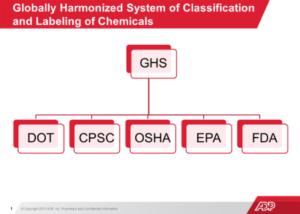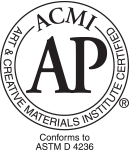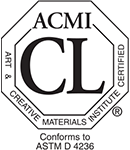All practitioners, manufacturers and purchasers of ceramics and pottery share a common concern for the safe use of ceramic materials, but defining “safe” and “safety” is forever changing. New studies and information are presented continuously, prompting government agencies to alter exposure limits to these chemicals, change product labeling, and so on. So what definitions of safety should we be concerned within the practice of ceramics?
Safety in a ceramic studio is defined by common sense and good studio practices as much as by-laws and regulations. Mayco provides up-to-date safety compliance with laws and regulations through product labels, SDS (Safety Data Sheets), Certificates of Compliance, REACH registration (for Europe), etc.
In pursuit of providing the highest degree of safety in ceramics, Mayco joined The Art and Creative Materials Institute, Inc. (ACMI) in May 2013. ACMI is a non-profit association of manufacturers of art, craft and other creative materials that sponsors certification programs for children’s and adult art materials, as required by product safety regulations, specifically “FHSA and “LHAMA” which governs the labeling of art materials in the US ACMI’s requirements for certification are more rigorous than other programs, such as voluntary testing for lead composition.
The best way to ensure a safe studio environment is to adopt a series of “best practices” that minimize risks and exposures. Below we’ll review some safety concepts, laws & regulations – and put them in perspective for your ceramic practice.
A hazardous chemical is a status: it is based on an assessment of the intrinsic properties of a chemical substance to cause harm, which is determined by scientific studies from hundreds of organizations throughout the world. Hazards are divided into three groups:
A health hazard substance enters/impacts a human being in one of four ways:
Any hazards to humans as determined by toxicologist review are clearly communicated on each product’s label.
Silica is the second most common mineral in the earth’s crust. It is a major component of sand, rock, and mineral ores like quartz. There are several types of silica. Two you may come in contact with in a ceramic studio might be “amorphous” silica – found in glass – and crystalline silica (quartz), found in every clay, glaze and piece of bisque. Most ceramic companies will list the CAS No . 14808-60-7 on their SDS as either Quartz or Crystalline Silica.
Long-term inhalation exposure to Crystalline Silica may lead to a condition called Silicosis. Silicosis is a chronic lung disease caused by breathing in tiny bits of silica dust. This silica dust can cause scar tissue in the lungs impacting your ability to breathe. In 2017 OSHA reduced the PEL (Permissible Exposure Limit) of silica by 50% – to 50 micrograms per cubic meter of air, averaged over an 8-hour shift.
Chronic silicosis, the most common type of silicosis, usually occurs after 10 or more years of exposure to crystalline silica at low levels. Inhalation is the only route of entry into the body that can cause Silicosis. Glaze, in the wet form, poses no inhalation danger unless spray applied. Spray application (spray creates mist, which can be inhaled) and mixing dry glazes can increase the chances for inhalation exposure and should never be done without the use of a NIOSH approved respirator.
Mayco has taken a “no spray application” policy on product labels to address the risk of inhalation exposure. Future labels will be revised as they come up for reprinting. We understand that spray application is popular in some markets and can be done very safely by wearing a respirator. We will leave the decision to use spray application up to each consumer but we urge extreme caution for respirable silica exposure.
Risk refers to the probability that an adverse effect will occur with specific exposure conditions. If you are using current ceramic materials and products, the greatest risk you’ll face in a ceramic studio is the inhalation of dust. The amount needed to cause damage over 10+ years of exposure depends on the individual. The amount of dust exposure you will encounter in your ceramic studio should be exceptionally low. But if you engage in an activity that creates dust: mixing dry glazes, cleaning greenware, spray application of glazes – wearing a respirator will limit your exposure and dramatically reduce your risk. Also, keep your space as free of dust as possible by frequent wet mopping or vacuum using hepa filters.
In this section we will briefly describe the roles and regulations of U.S. government agencies with respect to ceramic products and activities. State and local governments may also implement policies and regulations that impact ceramic activity. Mayco works diligently to make sure we are in compliance with all U.S., state and local laws, as well as with international laws and regulations, such as REACH in the EU.

Globally Harmonized System of Classification and Labelling of Chemicals (GHS) is a framework, an over-arching policy designed to standardize (or “harmonize”) all aspects of communicating about chemicals. All information, from the classification of materials to the phrases, labels, symbols we use, will become common throughout the world.
Each country that adopts GHS must decide which agencies are responsible for implementing aspects of GHS. In the U.S. there are 5 major agencies to whom this responsibility will fall:
As of this writing, Occupational Safety and Health Administration (OSHA) and the Department of Transportation are the only US agencies to implement GHS. The EPA and CPSC are in the process of developing a strategy to implement these standards. The adoption of GHS by OSHA prompted a revision of the MSDS, which is now SDS (Safety Data Sheets). Until other agencies begin to adopt GHS, current U.S. regulations will remain unchanged.
The 5 agencies listed in the graphic above and their responsibility towards ceramic product usage and safety are:
State and local agencies that can impact ceramic product usage and safety include:
The last bullet – identifying unhealthy or unsafe conditions – provides DOH officials a broad brush to become involved in the operations of a ceramic studio. Certain health department regulations are very specific and codified: for example, those that pertain to restaurant and food service environments. Other are more loosely governed by policies of general public nuisance. GPN covers a wide variety of issues that can threaten the health, safety, comfort, convenience, or welfare of a community.
While public employee safety – i.e. schoolteachers – is protected/governed under state departments of employee safety, student safety is not. Departments of Health usually take responsibility for governing student safety on a school’s premises. Student safety is a very grey area: as a general statement, specific laws and regulations do not exist. Given the lack of specific regulation, health officials can resort to any number of tools to guide them on matters of student safety. Our best advice is to be proactive with your local health officials and find out what their working definitions and sources of enforcement might be.
OSHA oversees the preparing of safety data sheets (SDS) and industrial product labelling by virtue of the Hazard Communication Standard (29 CFR 1910.1200). HazCom is impacted by the adoption of GHA as follows:
Important to Note: Consumer product labels are administered by the CPSC; the relevant laws and regulations governing these labels are reviewed below.
To download reference materials and current updates on OSHA and HazCom, visit the HazCom landing page
The purpose of the SDS are for manufacturers to communicate potential hazards to businesses that use their products in their business operations. As such, the SDS are not intended for use by consumers. The fact of the matter is the SDS have become the de facto standard for presenting chemical information for all users of a product. Given that SDS usage has become more widespread, here is an overview of the key sections with which you should be most familiar. As suggested above: review appendices 1 & 2, go to OSHA’s HazCom website for additional information.
Consumer safety laws and regulations are administered by the following three agencies: Consumer Product Safety Commission (CPSC), the Food and Drug Administration (FDA) and Departments of Health. In this section we’ll look at the main regulations and laws administered by CPSC.
The Consumer Product Safety Commission (CPSC) oversees product safety regulations and the communication of product warnings (primarily through package labels) . With respect to ceramic products, the significant CPSC regulations are:
The labeling of art materials under FHSA and LHAMA is as the consumer is exposed to it in its intended use. For us, it is the unfired form (liquid or dry) of the glazes and liquid acrylics- identifying any health risks the consumer may have in the use of the product.
As a member of ACMI, the appointed toxicological organizations (Duke Univerity and Bureau Veritas) evaluate our formulas in accordance with LHAMA. Products bearing the “AP” Seal are certified as to contain no materials in sufficient quantities to be toxic or injurious to humans, including children, or to cause acute or chronic health problems. Some glaze formulas contain a substance, such as soluble copper, which can present a health risk to the user and thus requires a Caution Label (CL). Glazes which feature a “CL” label will note the ingredient requiring the label and what precautions a consumer should take. CL products should not be used by children in grade 6 or lower.

The AP (Approved Product) Seal identifies art materials are certified in a toxicological evaluation by a medical expert to contain no materials in sufficient quantities to be toxic or injurious to humans, including children, or to cause acute or chronic health problems in the wet glaze. Such products are certified by ACMI to be labeled in accordance with the chronic hazard labeling standard, ASTM D 4236, and the U. S. Labeling of Hazardous Art Materials Act (LHAMA).

The CL (Cautionary Labeling) Seal identifies products that are certified to be properly labeled in a program of toxicological evaluation by a medical expert for any known health risks and with information on the safe and proper use of these materials in the wet glaze. CL products are NOT for artists ages 12 and under.
The CPSIA of 2008 amended many sections of several federal laws; the laws pertaining to the labeling of art materials (LHAMA) did not change.
The most significant impact of CPSIA of 2008 for art materials marketers was the requirement that a General Conformity Certificate (GCC) must be prepared for products “primarily intended” for use by children. This certificate is the documentation that shows that the product has been tested and meets appropriate standards. The certificate must accompany the product(s) either in paper or electronic form. The Commission intends to initially focus enforcement efforts on compliance with the underlying safety rules, rather than on the certificate or form of the certificate itself .” (CPSIA Guide for Small Businesses, Resellers, Crafters, and Charities, Feb. 2009, pg. 5). View Mayco’s Certificates of Conformity.
The CPSC provides a great many pamphlets and advisories for you to download. The main index for publications can be found on the CPSC website here.
Particularly useful is document number 5015: Art and Craft Safety Guide.